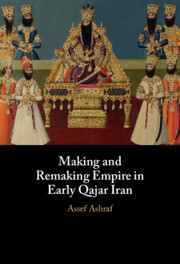Book contents
- Making and Remaking Empire in Early Qajar Iran
- Making and Remaking Empire in Early Qajar Iran
- Copyright page
- Contents
- Figures, Maps, and Table
- Acknowledgments
- Note on Transliteration and Terms
- Chronology of Key Dates
- Part I Frameworks
- Part II Centers
- 2 Land
- 3 Gifts and Tributes
- 4 Marriage and Masculinity
- Part III Peripheries
- Bibliography
- Index
4 - Marriage and Masculinity
from Part II - Centers
Published online by Cambridge University Press: 24 October 2024
- Making and Remaking Empire in Early Qajar Iran
- Making and Remaking Empire in Early Qajar Iran
- Copyright page
- Contents
- Figures, Maps, and Table
- Acknowledgments
- Note on Transliteration and Terms
- Chronology of Key Dates
- Part I Frameworks
- Part II Centers
- 2 Land
- 3 Gifts and Tributes
- 4 Marriage and Masculinity
- Part III Peripheries
- Bibliography
- Index
Summary
Chapter 4 argues that marriage and marital practices were central in producing and reproducing Qajar political power. While dynastic marriages had long mattered in the political history of Iran, it is difficult to find a parallel to their use during the early Qajar period. Fath-ʿAli Shah alone married over 160 women and fathered over 260 children, many of whom in turn entered into numerous marriages with notable figures. By the mid-nineteenth century, an important change with far-reaching consequences had occurred in Iran: the emergence of an entire class of Qajar ‘aristocracy,’ comprising thousands of princes and princesses, who were directly descended from or related to Fath-ʿAli Shah. This chapter draws attention to the shah’s marriages, to the social and regional background of the wives, and what the political considerations of the marriages were.
- Type
- Chapter
- Information
- Making and Remaking Empire in Early Qajar Iran , pp. 146 - 182Publisher: Cambridge University PressPrint publication year: 2024

